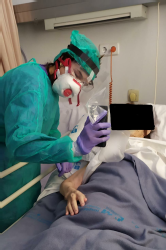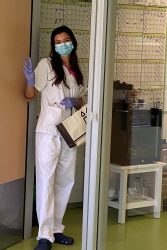I am a 26-year-old cardiology resident and part of the hospital’s multidisciplinary team treating COVID-19 patients. I have seen these patients suffer so much these past few weeks; not only physically but emotionally. They cannot see their families; they are alone and afraid. Many could not even speak to their loved ones because they did not have a phone or were too incapacitated to use one.
So, in our department, we began something we call CARDIO-CALL, because being separated from loved ones puts such a strain on the heart. From the very beginning of our residency, our director, Professor Pepe Zamorano, told us that it is important not only to cure but also to care. This is the spirit of our department and this is the spirit of “CARDIO-CALL”.
The department got us three smartphones so that I and two colleagues (also doing their cardiology residency) could implement this. We have quickly discovered that it’s not only the antiviral or antibiotic treatment that’s important to these patients, but a strong dose of love.
 Every day we select the most vulnerable. We help them call their families. Since leaving them in the Emergency Room, they have no idea what their relatives are doing and how they are reacting.
Every day we select the most vulnerable. We help them call their families. Since leaving them in the Emergency Room, they have no idea what their relatives are doing and how they are reacting.
For patients with a good clinical course, families are relieved to hear the news. For patients with a worse prognosis, especially if we know it may be their last call, it is a profoundly powerful experience – for the family, the patient and those of us holding the phone. Often, the patients look surprised to see their loved ones appearing on a screen. I remember one man who said excitedly, “it’s my daughter, I give a hug to daughter, I give a hug to my grandson”. He sent love to everyone in the family. His family cried.
The most moving aspect for me personally is to see the sudden change in a patient’s face when they recognise family members on the screen. Before the call they look depressed and tired. When they see their relatives, their faces light up, and they smile – the biggest of smiles. A sick face is immediately transformed into a happy face. They look like a different person. Everyone cries a lot, but I think it’s tears of happiness. The older ones who don’t understand technology try to grab the mobile phone to touch their relatives on the screen.
The sickest patients wear an oxygen mask. It’s harder for families when they see a loved one with a mask on their face. Patients can’t speak for very long because they get tired. It’s also uncomfortable to speak with a mask because of the oxygen flowing into the mouth. Understanding what patients are saying can be difficult, which is upsetting for families. It’s little words that make the difference. Families remind them of happy times, send a lot of hope and kisses and try to be reassuring saying, “please don’t be afraid, everything is going to be alright”. Patients usually say they are okay even if it’s not true. They also say they can’t wait to go home and be with their family. Almost every call includes the same phrases, over and over again: “I love you” and “I love you too”.
Even more important than words is seeing each other’s faces. Families imagine the worst and can’t relax until they see their relative’s face. Just a call is enough to reassure them.
We had a 52-year-old patient hospitalised with bilateral pneumonia because of COVID-19 who was using an oxygen mask. We held a video conference with his wife and daughter. It was difficult for him to speak clearly because of the mask and he quickly burst into tears. He had been really afraid that he would never see them again and they felt the same. His daughter, a 23-year-old medical student who had been at home for three weeks, said she felt completely helpless about his situation. After one and a half minutes, the patient started to feel tired and his respiratory rate increased so we had to finish the call. Although the call was brief and emotional, they could send their love and be comforted.
 It’s true that we risk becoming infected when we make these calls, and we are short of protective equipment. We try to save PPE by doing the calls after administering treatment so that we are already in the room.
It’s true that we risk becoming infected when we make these calls, and we are short of protective equipment. We try to save PPE by doing the calls after administering treatment so that we are already in the room.
When I started the videoconferencing, I didn’t expect it to be so emotional. It’s my job to be calm, but it is very difficult not to feel affected by these scenes. These are hard moments for people who care about each other. But I am so proud to help them connect, at a time when it is so vitally important to them all.


 Our mission: To reduce the burden of cardiovascular disease.
Our mission: To reduce the burden of cardiovascular disease.